Widely regarded as one of Egypt’s most beautiful and best-preserved temples, Dendera was established during the Greco-Roman era. But construction had been taking place at the spot since at least the Old Kingdom. An inscription on-site, meanwhile, states that the temple plans date from a far older era, when Egypt was ruled by semi-divine beings known as the ‘Followers of Horus.’
The main temple structure was started during the late Ptolemaic period. And it was completed during the reign of Roman Emperor Augustus, who became pharaoh of Egypt following the reign of Cleopatra VII.
But despite being built during a time of foreign rule, the temple follows Egypt’s tradition of, well, honoring tradition! Dendera is dedicated to Hathor, one of Egypt’s oldest and most important goddesses.
In addition to its breathtaking Hypostyle Hall, Dendera is also home to two famous carvings. Within an upper-level chamber is the unique Dendera Zodiac, while the subterranean crypt is home to a controversial relief that many call the ‘Dendera Lightbulb.’
Located about 65 km north of Luxor, Dendera is typically visited in tandem with Abydos. See more on arranging transport below.
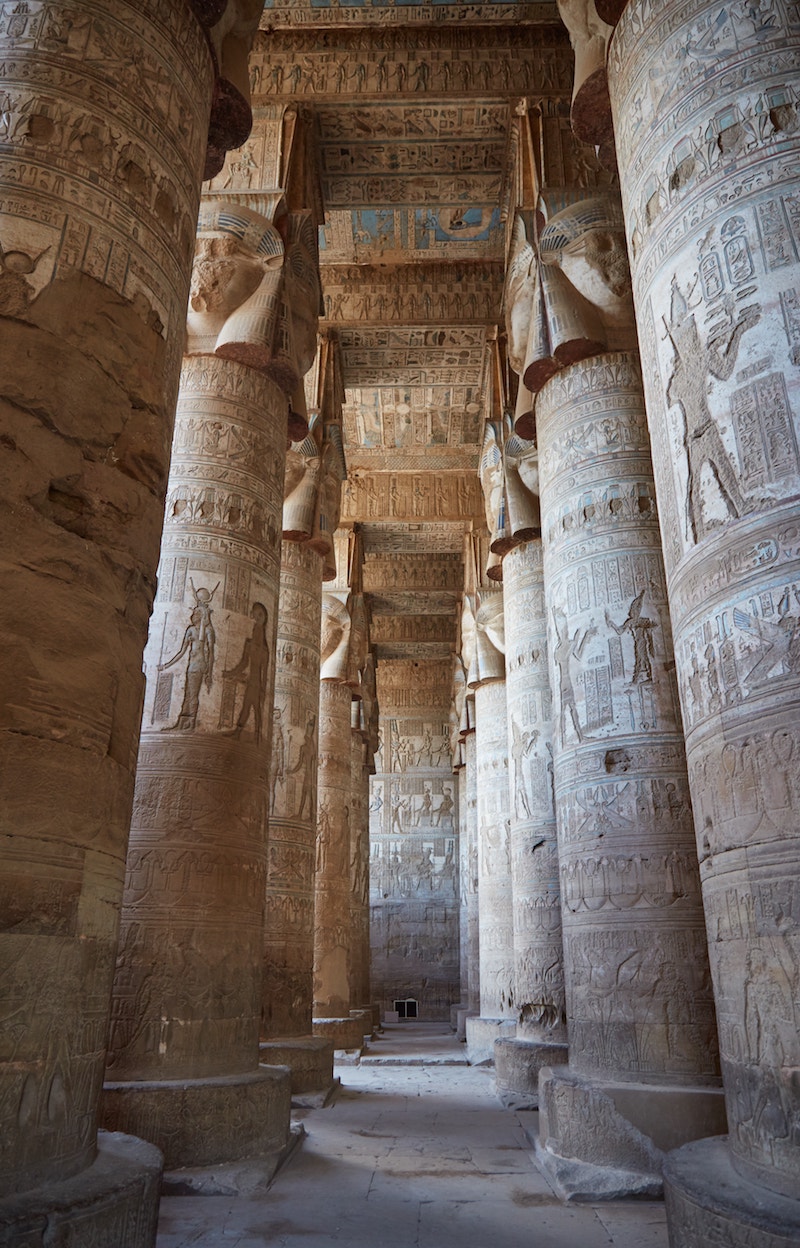
Dendera: The Temple of Hathor
Dendera was originally known as Enet-t-neter (Enet of the Goddess) which then became Tentyris in Greek. The Greek name was further corrupted to become Dendera.
In ancient times, the region was revered as an important center of healing, as Hathor was widely revered as a healing goddess. But Hathor was a complex, multifaceted deity with many sides.
The Greeks identified her with Aphrodite, the goddess of love and beauty. But her true role in the Egyptian pantheon was even more complicated than that.
Hathor

As the source of divine nourishment, Hathor was often depicted as a cow. And throughout Egyptian temples, reliefs of royals drinking straight from a cow’s udder were quite common.
Alternate depictions showed Hathor as either a full human or as a cow-headed woman – both of which you’ll find around Dendera. And at the top of columns, she has a human face but with cow ears.
Hathor represented the cosmic womb. She’s more of an abstract goddess than Isis, who represented the archetypal feminine principle in human form. Hathor’s roles were more impersonal and metaphysical.
Notably, Hathor means Hat-hor, or House of Horus. Hathor was a consort of Horus, the son of Isis and Osiris.
Accordingly, the Temple of Dendera was linked with the Horus temple of Edfu. And in ancient times, yearly pilgrimages and processions took place between the two temples.
Hathor was generally revered as a benevolent and motherly goddess. However, she also had a destructive side. In the Book of the Divine Cow, for example, Re commands Hathor to punish mankind for their misdeeds.
To do so, Hathor turns into a raging lioness, Sekhmet, but becomes wild to the point that she can only be subdued with copious amounts of wine. (Interestingly, Sekhmet continued to be worshipped as a distinct entity.)
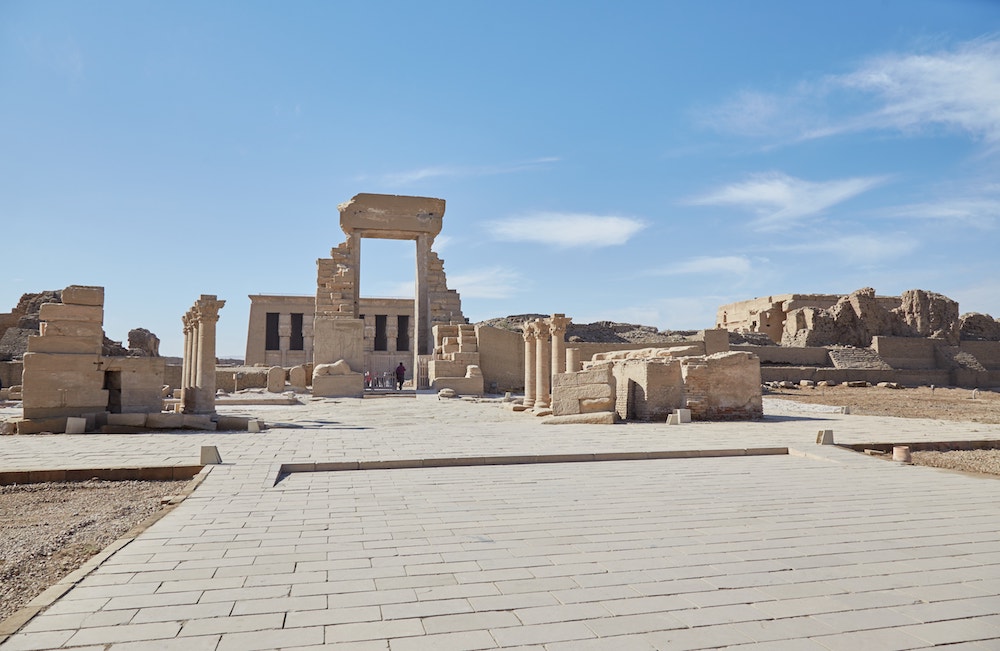

Approaching Dendera Temple, you’ll notice that it lacks the traditional pylon gate at its entrance. Instead, all that stands in front is the remnant of a small gate erected during the reign of Roman emperor Domitian (81-96 AD).
There’s a lot to explore around the courtyard, but for now let’s head straight to the temple.

The front of the temple is lined with six columns that have Hathor-headed capitals. But even more impressive are the columns that entirely fill up the Dendera’s first room, the Hypostyle Hall.
The Hypostyle Hall
Dendera’s Hypostyle Hall is one of the most well-preserved, colorful and photogenic parts of any surviving Egyptian temple. Completed around 2,000 years ago, the level of detail is astounding.
The room contains 18 columns in total, each of which is topped by four-faced carvings of Hathor. As you’ll notice throughout your travels, Hathor is the only deity in Egypt with her own column.
But given Egypt’s incredibly long history and extensive pantheon, why just her?
The Egyptians never left us with a definitive answer. But the tops of Egyptian columns represented the heavens, and Hathor’s position here likely corresponds to her symbolic role as the cosmic womb.


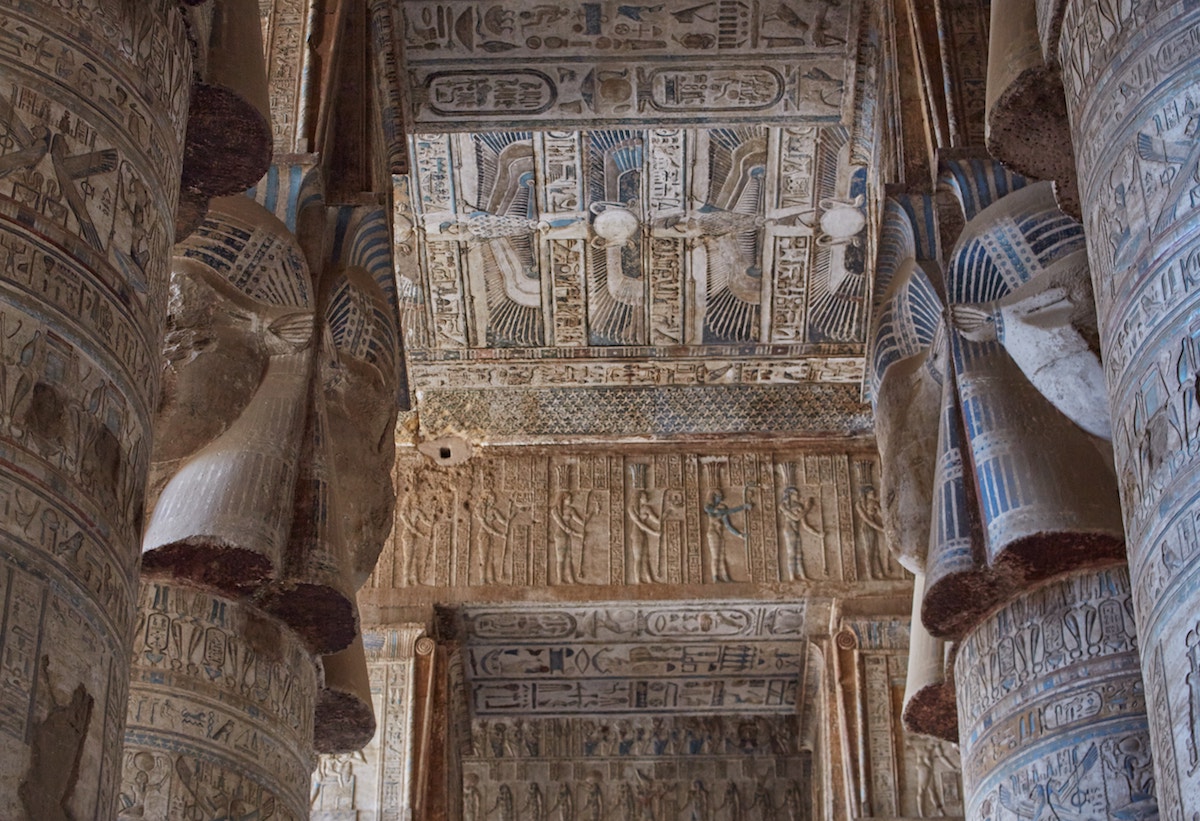

This particular depiction of Hathor shows her with a human face but with cow ears. Interestingly, the shape of the face resembles that of a uterus. Given the ancient Egyptians’ comprehensive understanding of human anatomy, this was surely no coincidence.
Furthermore, the entire columns, including the face of Hathor and the box-like shape at the very top, resemble a sistrum. These ancient musical instruments were percussive rattles that were played during joyous celebrations, such as the Egyptian New Year festival which took place at Dendera.
As is common at Egyptian temples, imagery can take on multiple symbolic functions at the same time. When we take a look at the ceiling of Dendera’s Hypostyle Hall, we can surmise that the sistrum imagery also represented the natural rhythm of the heavens.


Looking up from either end of the room, we can see the sky goddess Nut and the signs of the zodiac. Nearby Nut’s leg is a crab representing Cancer. But why is Cancer placed here while the other signs are depicted neatly along the two registers?
And as we’ll see at the circular zodiac carving on the upper floor, Cancer is also placed near the very center of that image.


When 19th century Egyptologists and astronomers first came to study Dendera, the placement of the crab was not overlooked. Many early researchers concluded that the Egyptians themselves believed their civilization had begun during the Age of Cancer.
When Dendera was established, the vernal equinox sunrise rose in the last degree Aries. The Age of Aries began around 2160 BC, while the First Dynasty of Egypt started around 1,000 years prior during the Age of Taurus.
But the Age of Cancer occurred much earlier than that, lasting from 8,640 – 6,480 BC (the dates vary somewhat depending on the source). Unsurprisingly, modern Egyptologists entirely dismiss the notion that Egyptian civilization could be that old.

But as mentioned above, the plans for Dendera Temple were said to have been found on a goatskin scroll dating back to the time when the ‘Followers of Horus’ ruled Egypt.
According to the Egyptians themselves, semi-divine beings ruled the country for tens of thousands of years before the reign of the ‘first’ pharaoh, Narmer.
In fact, the precise dates for these reigns are included in the Turin Kings List and the records compiled by Ptolemaic-era priest Manetho. Despite modern Egyptologists basing much of their work on the dates provided by Manetho, the earlier period that he details is ignored entirely and disregarded as pure mythology.
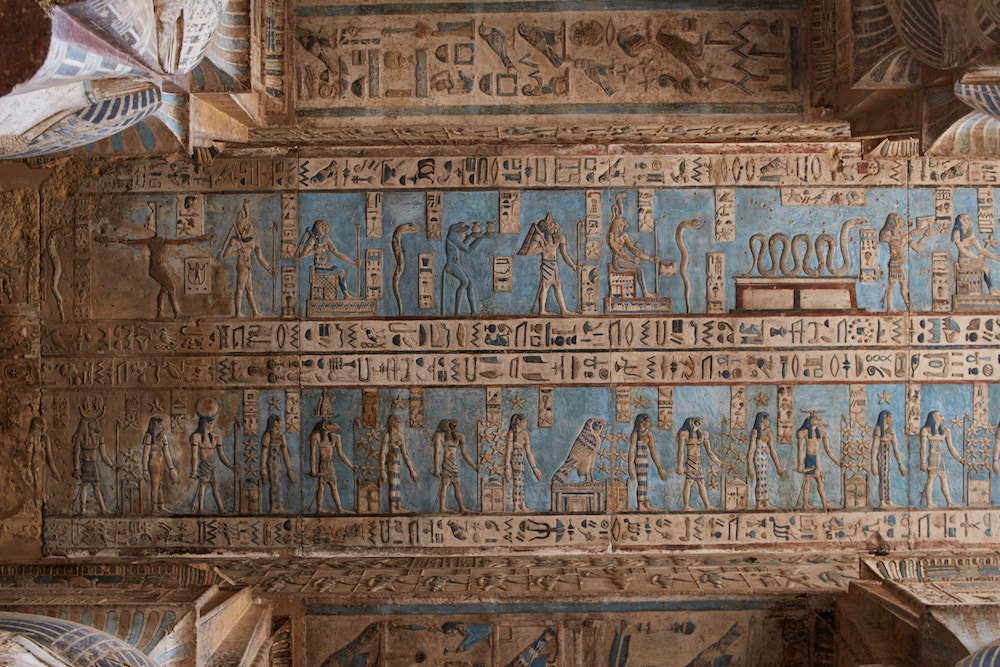

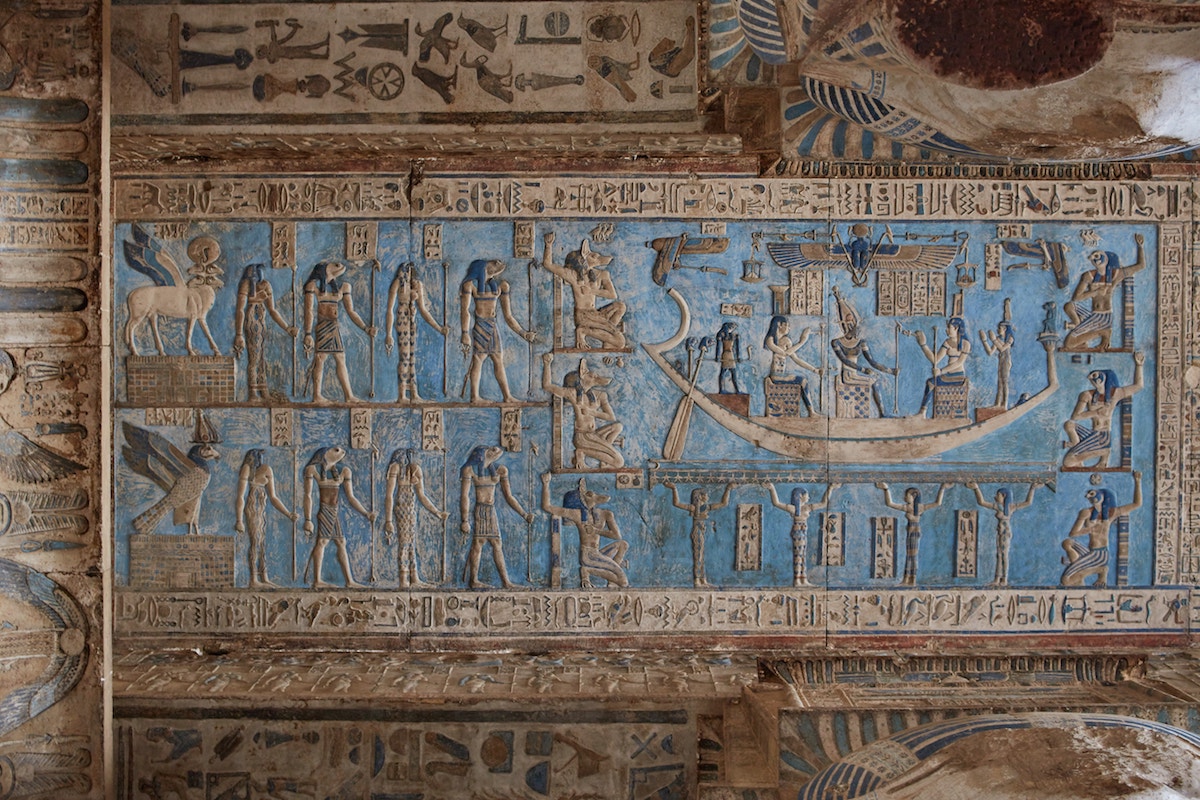
With the zodiac represented along the far ends of the room, the next aisles represent the decans, a subdivision of the zodiac. There were 36 decan stars that rose in a particular order on the horizon each day, and they played an important role in the Egyptian calendar system.
The two aisles on either side of the center, meanwhile, represent the phases of the moon. The three cycles together, therefore, form a complete map of the heavens.
And the link between these cycles made up the natural rhythm of the cosmos, which was symbolized by the rhythmic shaking of the sistrum.




The central aisle, meanwhile, is entirely adorned with vultures enveloping a sun disk. In ancient Egypt, the vulture traditionally represented the concepts of assimilation and primordial reconciliation.
After the fall of ancient Egyptian civilization, Dendera was neglected, and this hall was half-filled with sand. Local villagers took refuge here, even establishing a little village within the temple.
But they had no regard for the fantastic ceiling art, regularly building fires inside. Eventually, the ceiling became totally blackened, and it remained that way for centuries.
The ceiling was completely repainted fairly recently. And whoever carried out the project did an excellent job. The art appears vibrant without looking too artificial or modern.
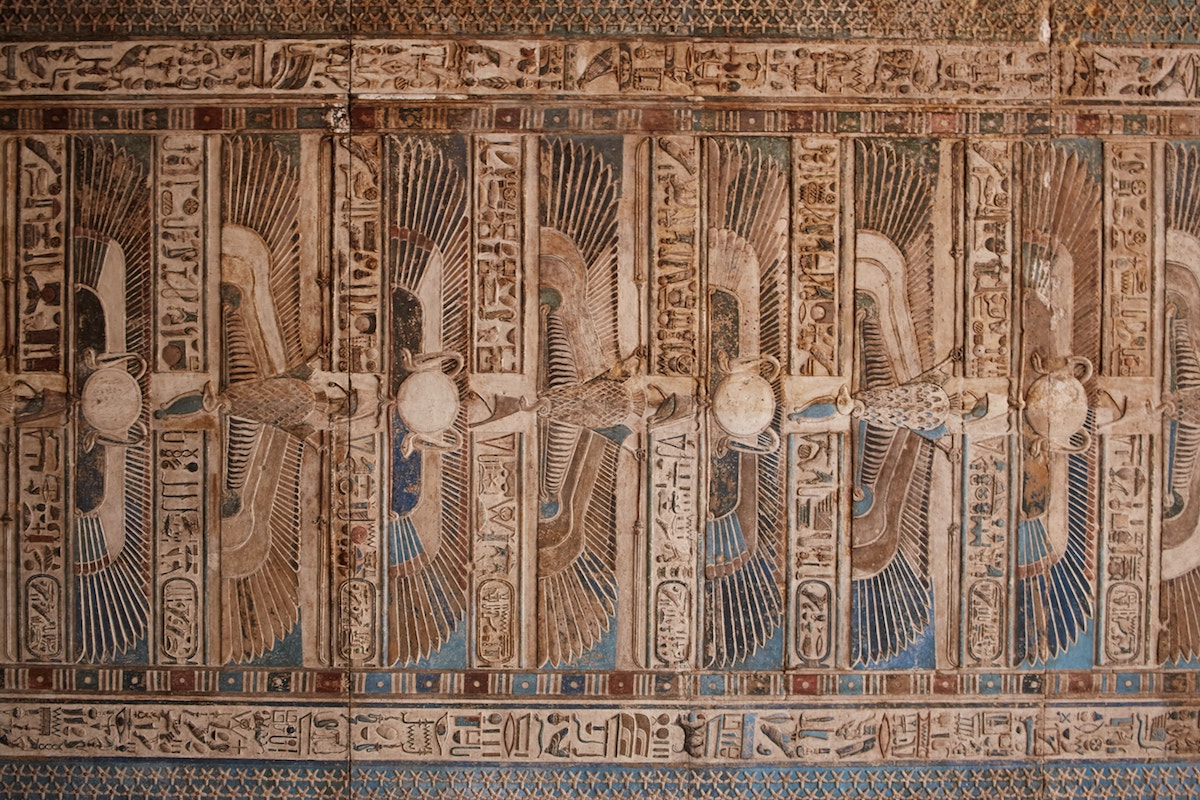
The walls of the Hypostyle Hall are completely decorated as well. They feature traditional Egyptian ceremonial scenes of pharaohs presenting offerings of sistrums to Hathor and other gods.
But in this case, the pharaohs are actually Roman emperors. Among them are Augustus, Tiberius, Caligula, Claudius, and Nero, most of whom had never visited Egypt.
As was common throughout the Greco-Roman era, the characters appear rather pudgy. The flabby bellies of the pharaohs remind one of Amarna art, though this was surely coincidental.


Beyond the main Hypostyle Hall is a smaller hall of columns that was completely obscured by scaffolding during my visit. But peering through the gaps, I could see floral capitals typical of the Greco-Roman era. (This hall should be completed soon sometime in 2021.)
The multiple rooms surrounding this hall served as storehouses, treasuries and sanctuaries.


The Inner Sanctuaries
Past the columned halls are a series of sanctuaries which made up the most sacred portion of the temple. But with all of the statues and altars missing, the shrines have lost much of their splendor.
The main Inner Sanctuary is its own small building in the very center. In ancient times, only the king and priests could enter here – and possibly only during the annual New Year festival.


Dendera Temple and other Ptolemaic-era temples are special for having formerly secret texts displayed prominently on the walls. While we don’t know what the priests were thinking, they possibly had an inclination that the Egyptian religion was nearing its end.
As many aspects of the Egyptian religion were closely guarded secrets, only shared among a small group of initiates, there wasn’t much written down. And it’s thanks to temples like Dendera and Edfu that we’re aware of some of these rites at all.


Most scholars, however, are only familiar with the Egyptian language commonly used from around the Middle Kingdom era. By the Ptolemaic period, the writing style had changed dramatically, containing all sorts of new contractions and puns.
So despite these obscure rituals being inscribed in stone for us, we have a long way to go before fully deciphering them.
Moving on from the central shrines, there are over a dozen additional shrines dedicated to gods like Isis, Sokar, Re and those of the local Dendera nome.




The chamber directly behind the main sanctuary is where Egypt’s past was linked with its present. The space once contained statues from the Old Kingdom, such as a golden statue of Pepi I of the 6th Dynasty.
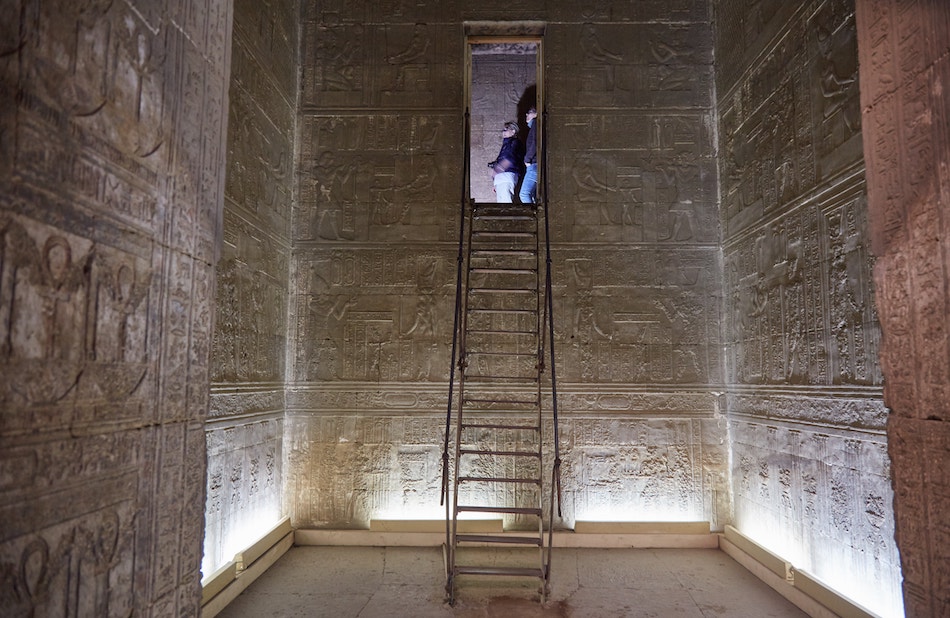


Meanwhile, a ladder leads up to an additional niche. And this is where important statues of Hathor would’ve been kept. Interestingly, on the other side of the wall is a large relief of Hathor where the public could come to present offerings (see below).
This is one of many examples where the reliefs on one side of a wall directly corresponded to the reliefs on the opposite side. Nothing in an Egyptian temple, therefore, should be examined in total isolation.

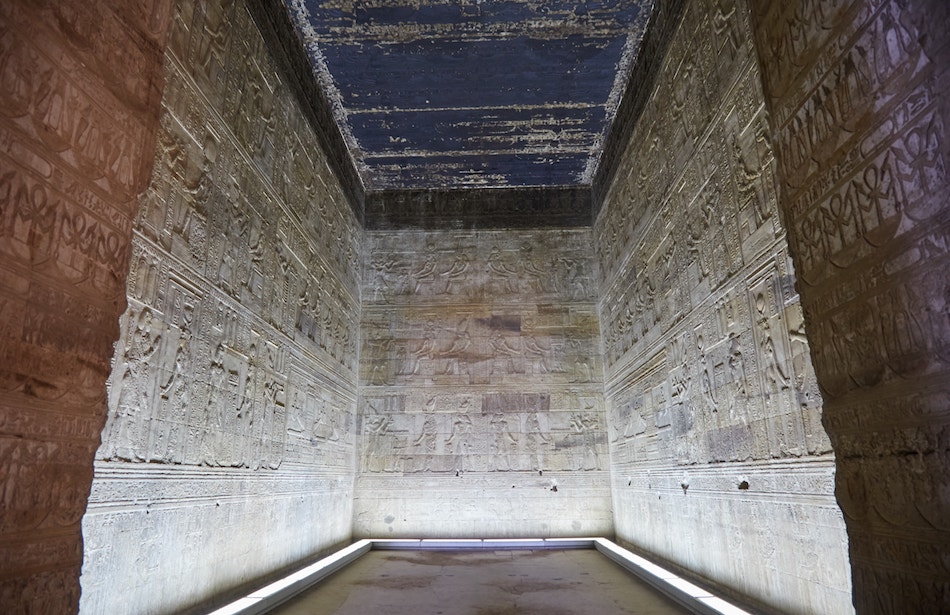

Off to the side is an additional smaller chapel, known as the Chapel of the New Year, set in its own little courtyard. The chapel ceiling depicts Nut giving birth to the Sun. This imagery, along with the other reliefs, represent creation and order emerging out of chaos.
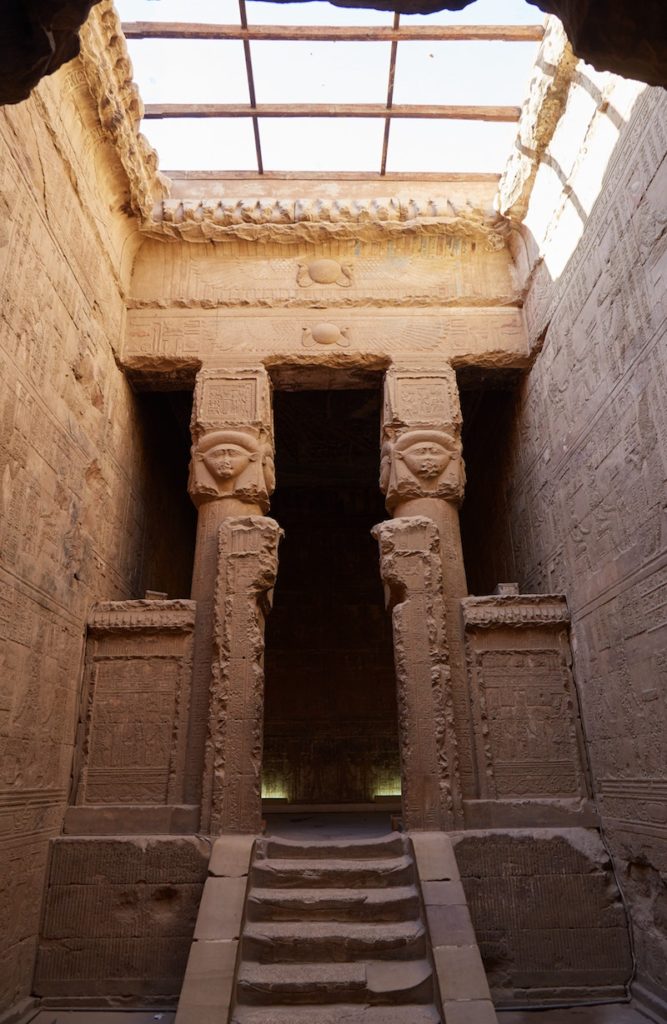

The Dendera Zodiac
Nearby the Chapel of the New Year is the western staircase which provides access to the roof (there’s also an eastern staircase on the other side). As you walk up, you’ll notice the detailed reliefs completely adorning either side of the wall.
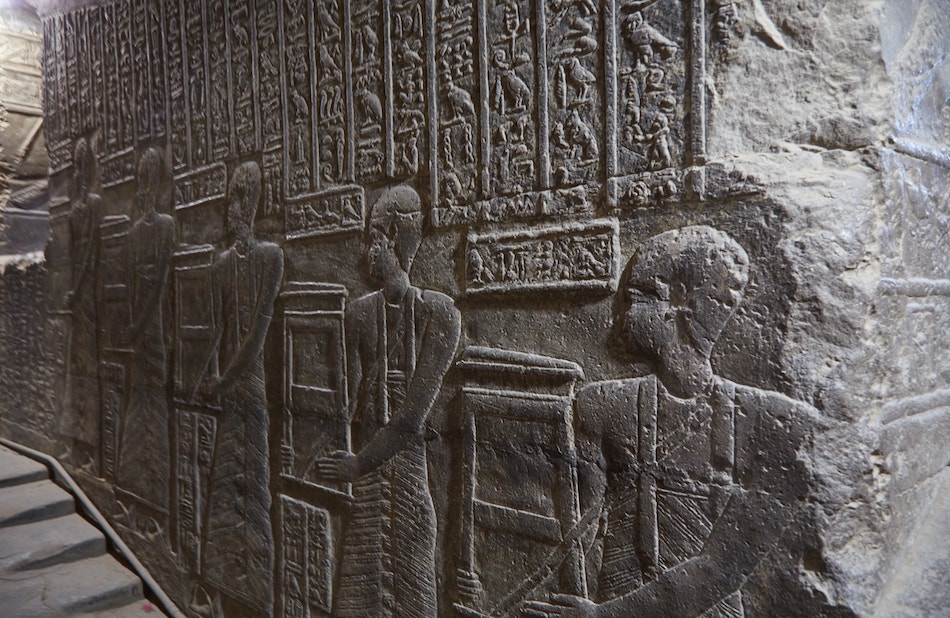
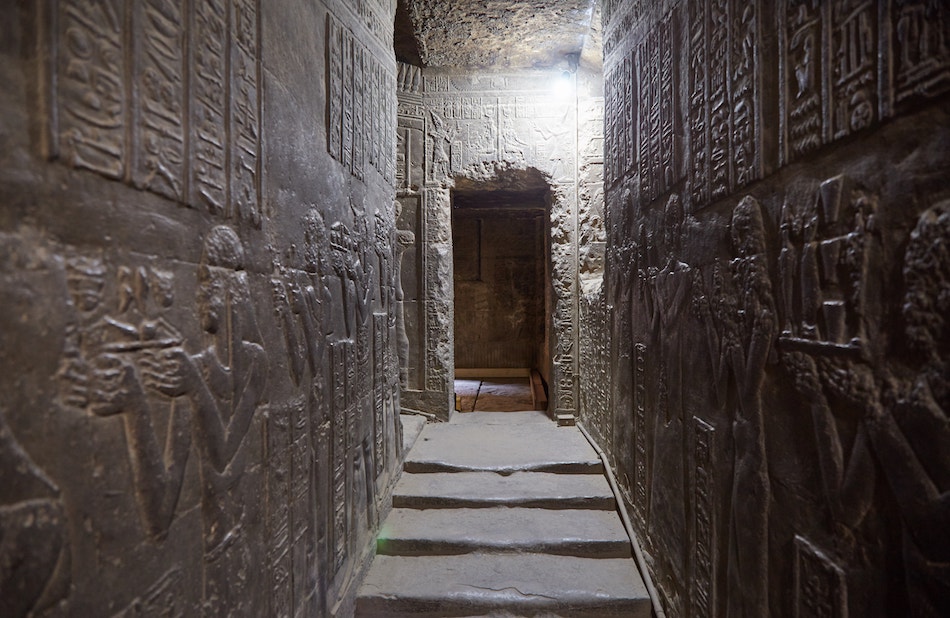
Coming up from the western staircase, you’ll first encounter a series of chapels dedicated to the Osiris/Isis/Horus myth. This is one of Egypt’s most fundamental myths that was celebrated from the beginning to the very end of its civilization.
Due to their proximity to one another, most visitors see both Abydos and Dendera temples on the same day. As the Temple of Seti I at Abydos was dedicated to Osiris, it’s worth brushing up on the myth before this day trip.
Check out a brief summary in our Abydos guide right here.


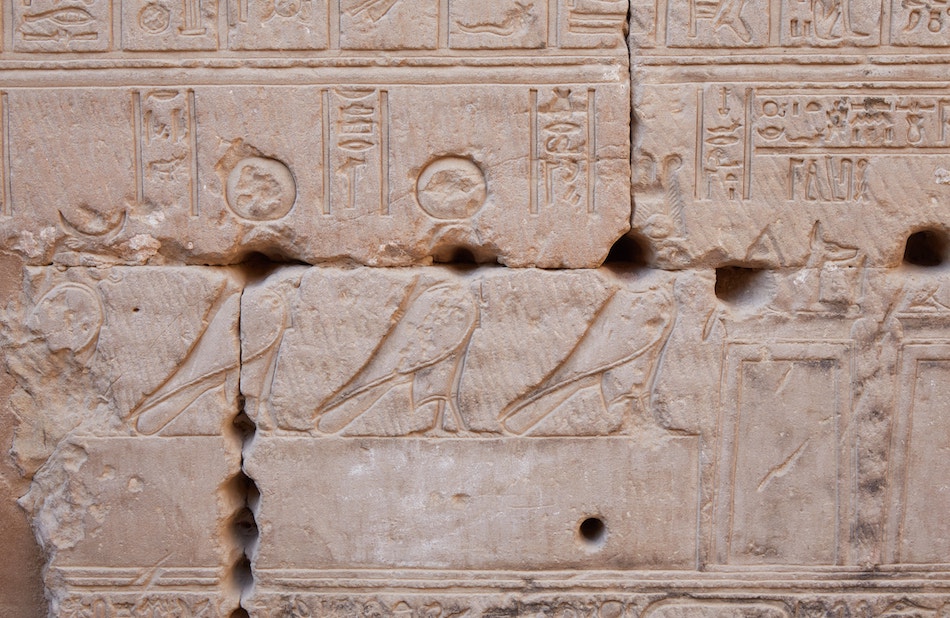

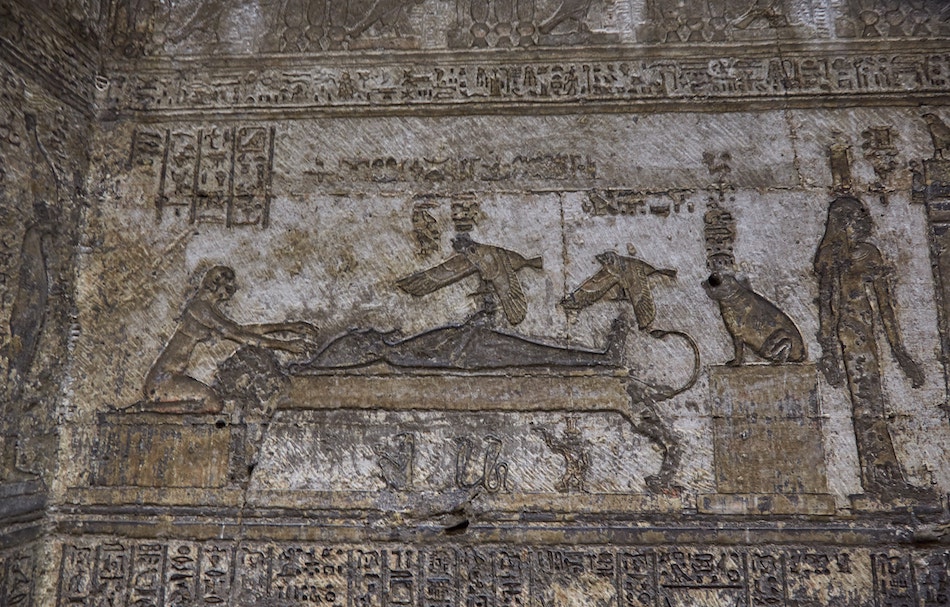
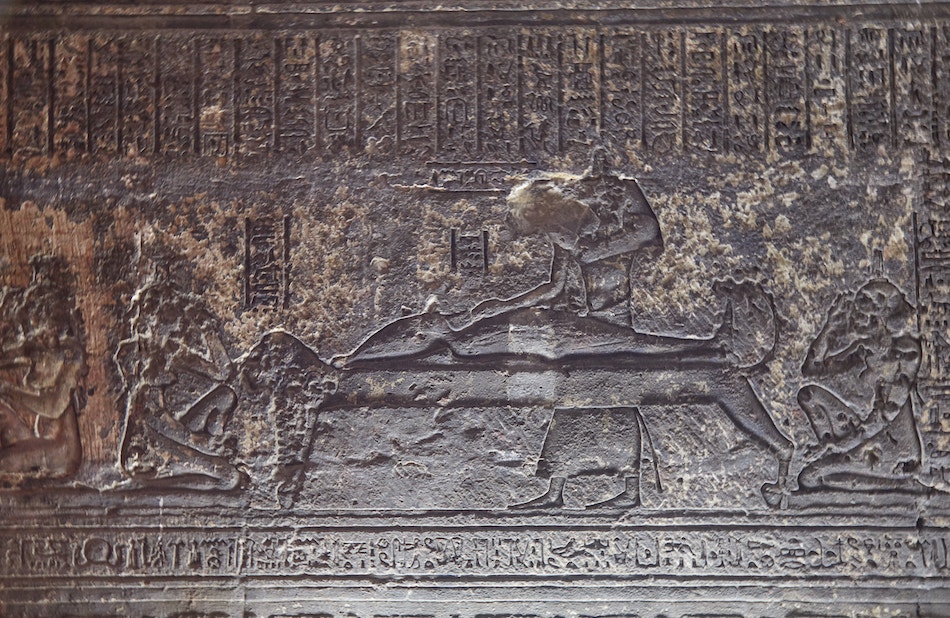
Nearby is a small open-air Hathor kiosk. You’ll then want to walk all the way around to the eastern side of the rooftop to find the famous Dendera Zodiac.
But also be sure to stop for the views of the complex and the remarkably preserved mudbrick enclosure walls.

The Dendera Zodiac is the only circular zodiac that was ever found in Egypt. And it’s clear that its style was imported from the Greeks, who in turn borrowed it from Babylon.
The original carving is actually in the Louvre and what we see today at Dendera is a replica. Its creators even went as far as copying it in its blackened state!
Given how the ceiling of the Hypostyle Hall has recently been repainted, it would nice to see a full-color recreation of the Dendera Zodiac sometime in the future.

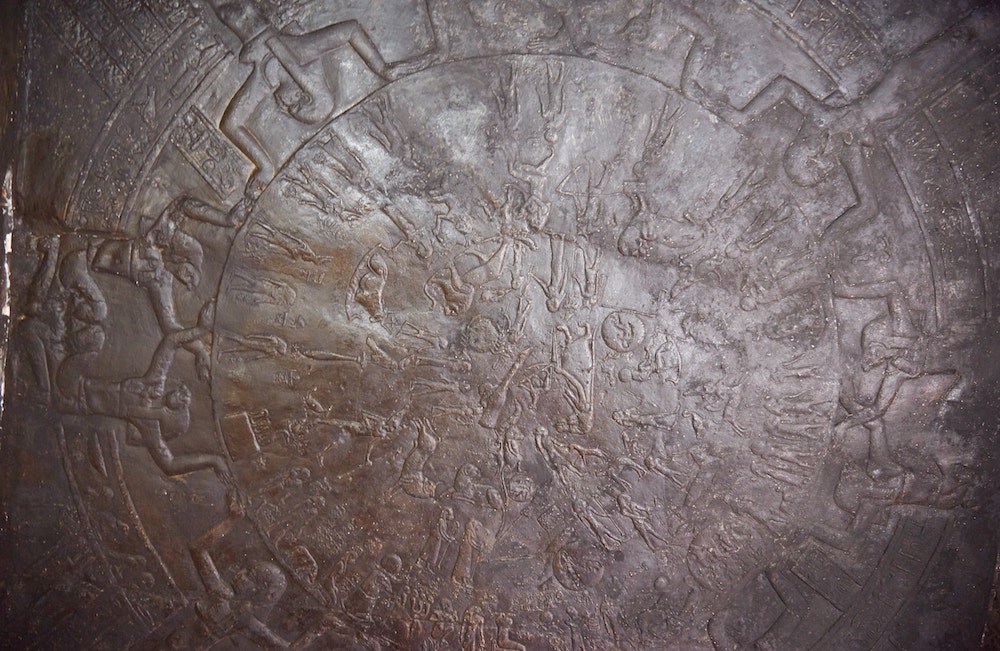

In the Dendera Zodiac, stars like Draco are represented by the hippo and the Little Bear by Anubis. Furthermore, Aquarius is represented by the Nile River god Hapi. The five planets, meanwhile are depicted as gods holding staffs. But other representations are closer to what we’re used to.
As mentioned earlier, the Crab signifying cancer is placed close to the center, with other signs of the zodiac following counterclockwise.

The Crypt (Dendera Lightbulb)
Coming back down from the roof, be sure to visit to the crypt to see another enigmatic carving. While there are actually a few different crypts at Dendera, only one section is currently accessible to visitors, and you can ask the temple guards to show you the way.
The crypts functioned as repositories for ceremonial objects, including the ba statue of Hathor. Many of the reliefs here date back to the time of Ptolemy XII (80-51 BC), making them among the oldest at the temple.


Many of the carvings depict statues that were kept at Dendera Temple, along with calendrical information related to special holidays and ceremonies. But the real highlight is the set of mysterious carvings on either side of the chamber’s end.
Here we see beings holding what appear to be lightbulbs – at least to our modern eyes. As is the case with the helicopter and submarine imagery at Abydos, many alternative researchers have taken the imagery at face value.
The ‘Dendera Lightbulb’ carving, some claim, is evidence that the Egyptians had electricity and lightbulbs in their time.



In fact, there’s plenty of evidence to suggest that the Egyptians had way more advanced technology than modern scholars give them credit for. There’s just no way that many of Egypt’s great masterpieces could’ve been created with nothing but stone and copper tools.
And if they could, why can’t Egyptologists recreate a single granite obelisk or even a miniature replica of the Great Pyramid?
In regards to light in particular, the Serepeum in Saqqara is especially mysterious. The crypt is entirely filled with massive granite boxes. But nothing on the ceiling indicates that the workers carried lit torches. So how could they see? Egyptologists have no answer.

But in this particular instance, the ‘Dendera lightbulbs’ are unlikely actual lightbulbs. They were merely a fresh way to portray very ancient religious ideas.
The serpents represent the split from unity into duality at the beginning of creation. Notice how the serpents emerge out of lotuses, a common symbol associated with creation in Egypt as well as India.
We can also see a djed pillar holding one of the serpents up. The pillar was a traditional Osirian symbol representing the stability of the universe.
On a microcosmic level, meanwhile, the spinal imagery next to the serpentine imagery likely signifies kundalini energy rising up the spine.

Around the Temple Complex
After finishing up with the interior, the rest of the expansive temple complex is well worth checking out. Don’t miss the back wall which features a large carving of Hathor in the center.
As mentioned above, this exact point corresponds to the elevated shrine inside where a statue of the goddess was kept. And this is where ordinary citizens who were barred from entering the temple would come to pray to the Great Mother Goddess.
Supposedly, the image’s damaged state is the result of its stone being scooped away by pilgrims over the course of centuries!

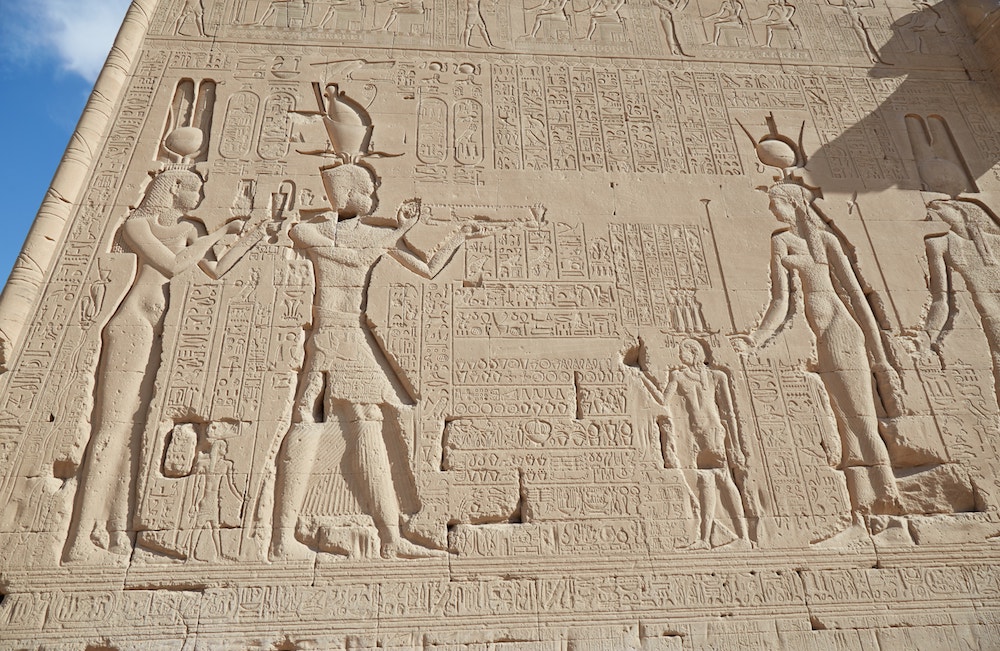

Elsewhere, deities such as Isis and Horus receive offerings from the royals. And among the royals depicted are Cleopatra VII (the famous one) and Cesarion, her son by Julius Caesar. Interestingly, these images were carved after Cleopatra’s death.
While Cleopatra (69-10 BC) is among the most famous historical figures of ancient Egypt, not many people realize that her era is closer in time to the iPhone than it is to the Great Pyramid!


Directly behind the temple is a small birth shrine of Isis. And further west (the right side of Dendera Temple when facing the entrance) is a dried-up Sacred Lake.
These lakes were a common feature at Egyptian temples, and they symbolized the primordial waters at the beginning of creation.
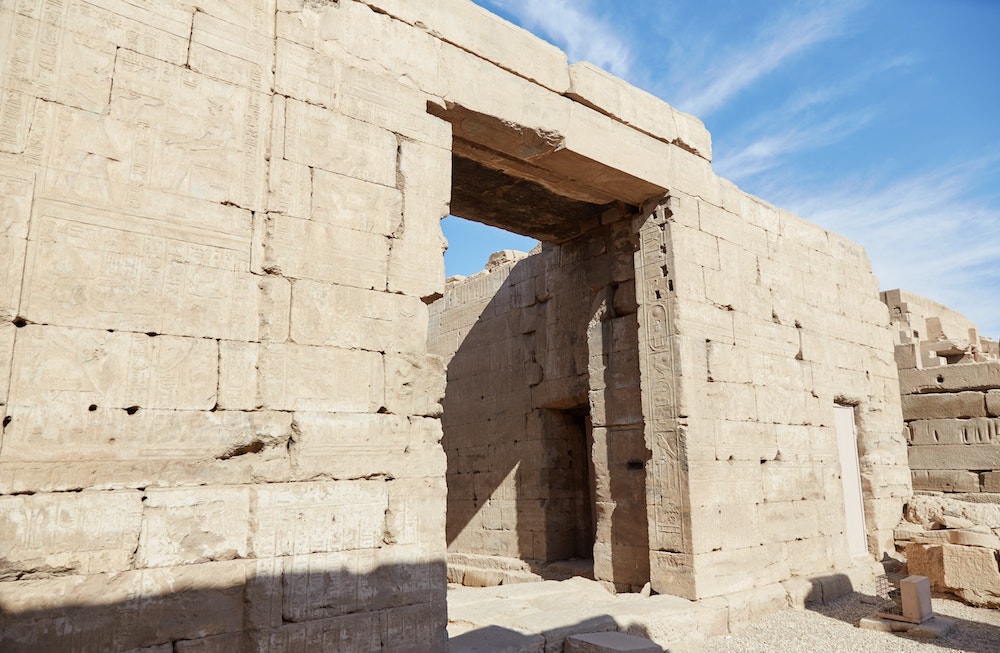

Continuing further north back toward the entrance, you’ll encounter structures like a Sanatorium and the Birth House of Nectanebo (380-62 BC), the last native Egyptian pharaoh. Obviously, this structure predates Dendera Temple as we see it today.
Birth Houses at Egyptian temples became popular during the Late Period and Ptolemaic eras. They often depicted the divine birth of the king, similar to the New Kingdom scenes at the Mortuary Temple of Hatshepsut and Luxor Temple.
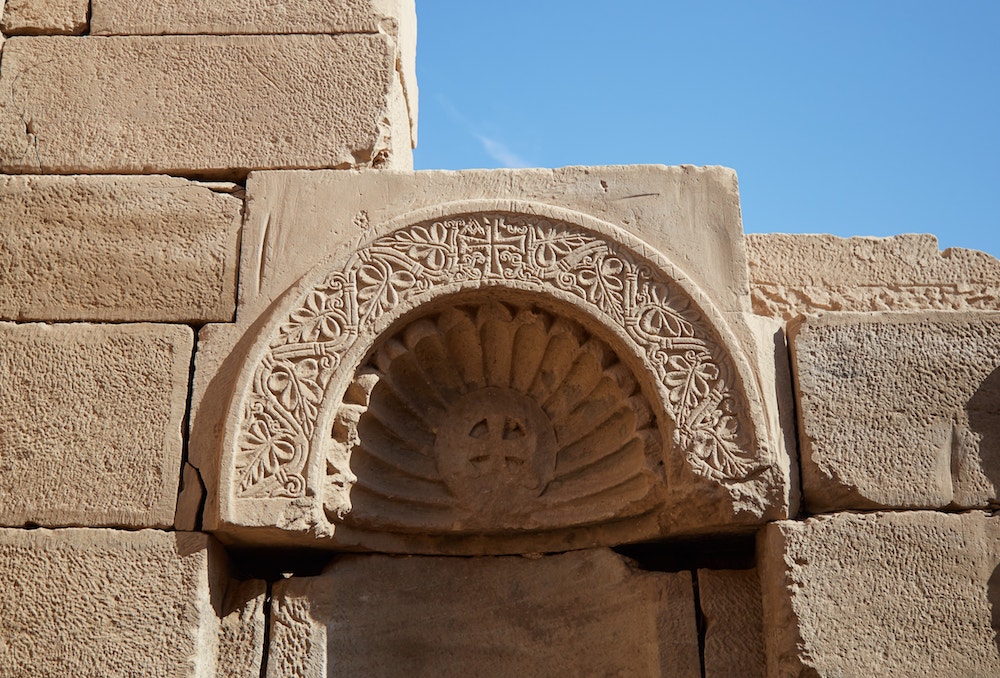

Continuing further, you’ll pass by the ruins of a Coptic Church and a much more elaborate Birth House dedicated to Nero.
However, it also contains reliefs added by later emperors like Trajan and Hadrian. The well-executed art is absolutely worth a look on your way out.
And before you leave, you might want to take one more look at the Hypostyle Hall, as there’s simply no other room in Egypt quite like it.
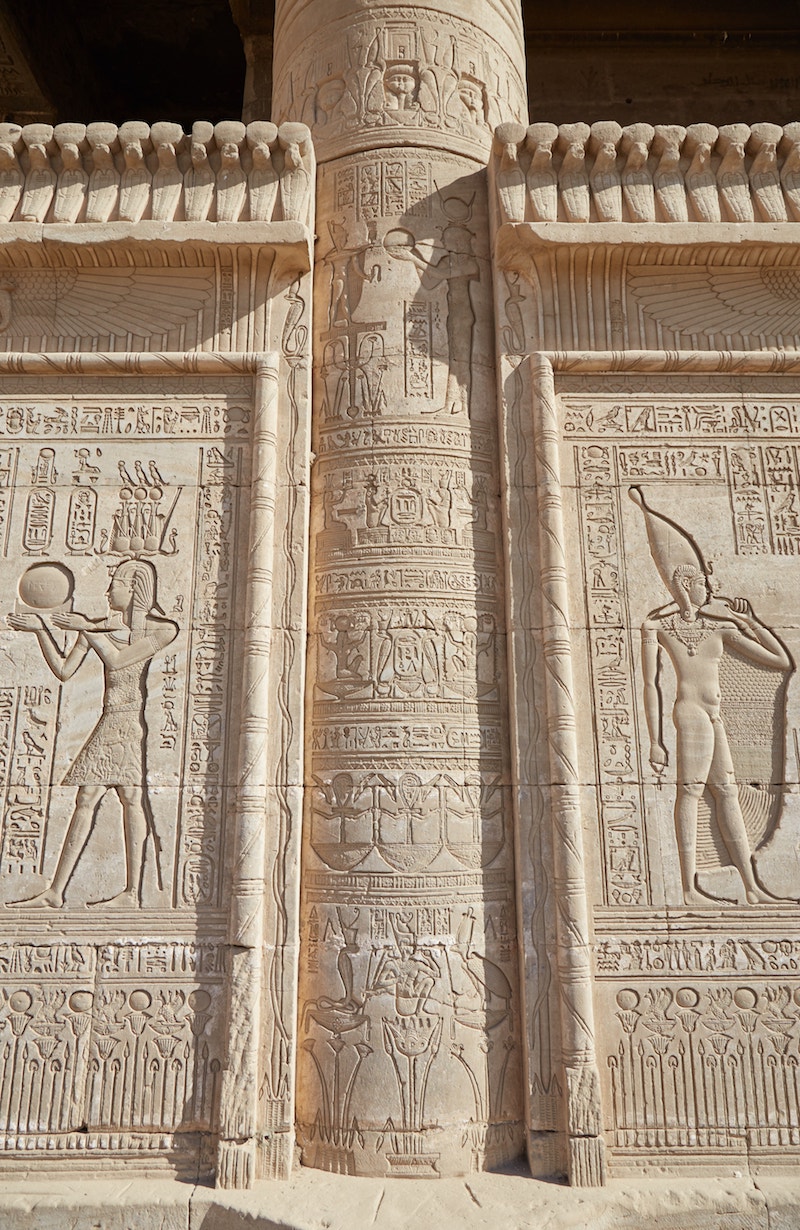
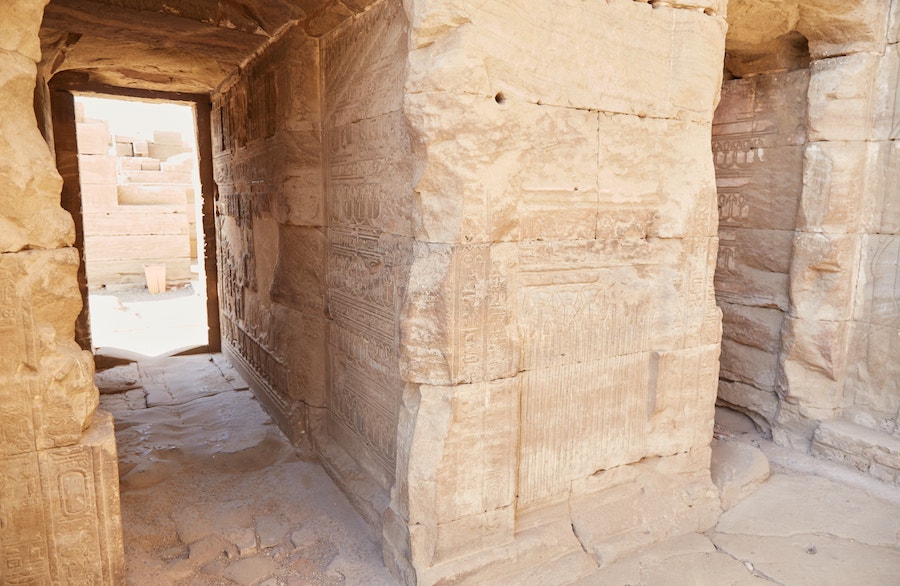
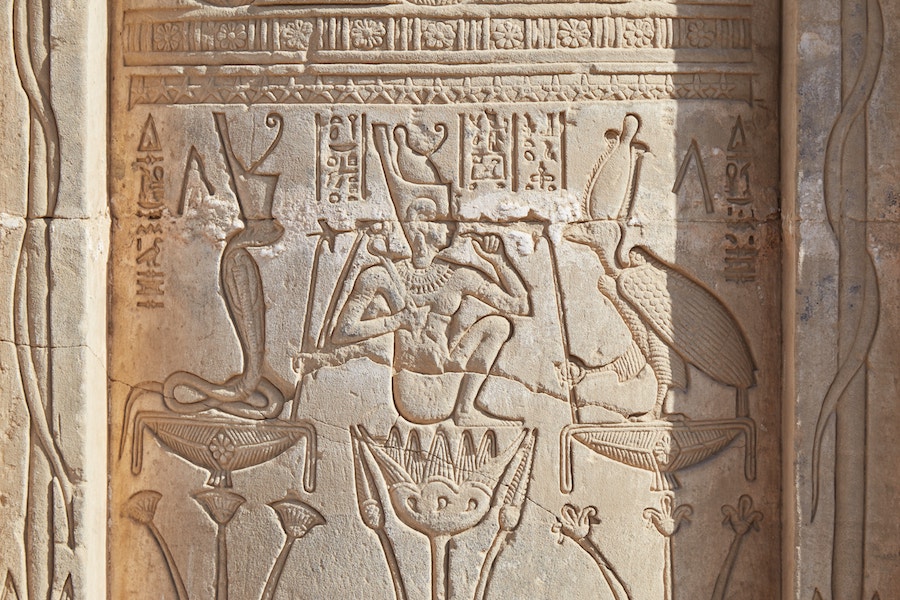

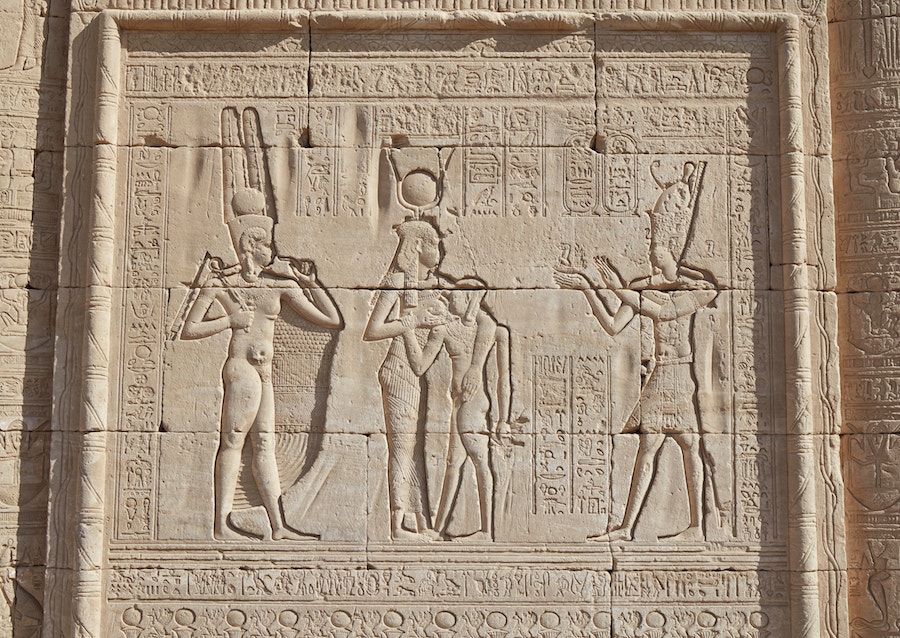
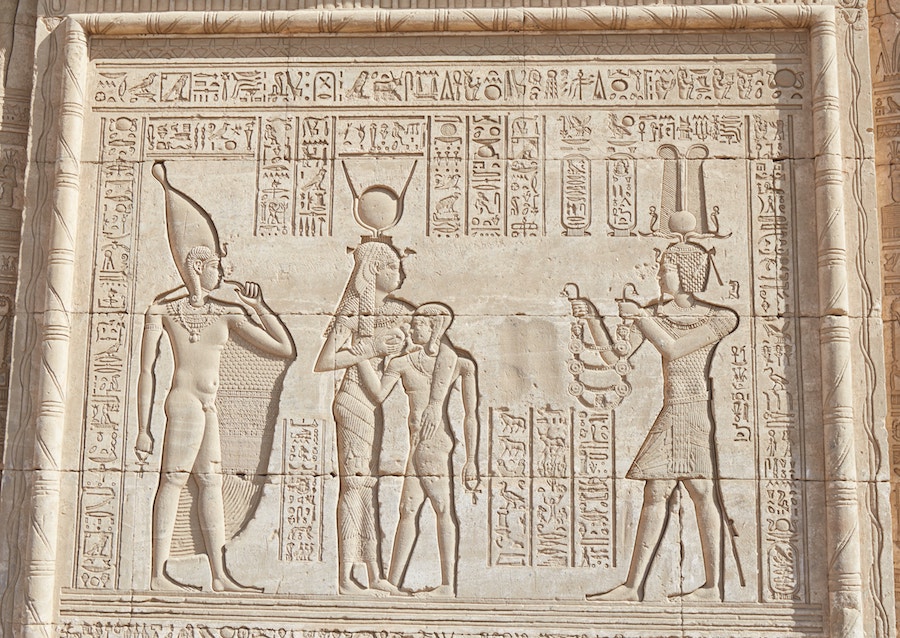
Additional Info
Dendera, about 50 km north of Luxor, can easily be visited as a day trip, and it’s often combined with a visit to Abydos. As these two temples are arguably Egypt’s very finest, this day trip is essential for all visitors to Luxor.
Sadly, the journey is much more expensive and complicated than most people would imagine. Despite the popularity of the temples, there are no organized group day trips from Luxor. That means you’ll have to arrange a private driver to take you.
I was staying on the west bank of Luxor, and I arranged the trip through a company called Classic Tour Services which has an office there. Everything went smoothly and I’d recommend them to anyone staying on the west bank.
I paid a little over $100 USD, which was a lot more than I was expecting to pay before arriving in Luxor. This was just for a driver and no guide (which is how I prefer it, as I had a great guide book with me).
Many of the prices mentioned on Tripadvisor, even from a couple years ago, are no longer relevant. To compare prices, I asked at a few other tourism offices and at my hotel. And I also chatted with some private drivers by the river. But nobody was quoting me under $100 for both temples. (But if you’re going to Dendera only, you can arrange the trip for much less.)
Also, be careful of cheap tours on Viator. I originally booked a trip for $70 and thought I was getting a great deal. That is until they cancelled on me just two days before with no explanation!
The reason the day trip is so expensive is partly due to the security situation. Part of the money you pay covers the police escort required to visit the area as a foreigner. I’m not quite sure what the deal is, but there is a very heavy security presence around both temples and especially at Abydos. Apparently, it’s been this way for years.
Before the trip, you’ll need to provide your passport information to the driver or tour company a couple days in advance. They’re then supposed to pass this info onto the police.
During the journey, I wasn’t asked by any officers to show my ID, though they did repeatedly ask my driver where I was from. He also got repeated calls throughout the day to confirm our location. Supposedly, they’re worried about a possible abduction or anything that would be bad PR for Egypt’s tourism industry.
I’ve read on some blogs and also sites like Wikitravel that taking the train to either temple is a viable option. However, after looking more into it and reading various peoples’ comments on the Tripadvisor Egypt forums, this seems like a bad idea.
Train travel in Egypt is fine for long distances (like from Cairo to Luxor), but is highly unreliable for day trips. There are often only a couple trains a day and they’re commonly late. On top of this, the whole security situation makes the matter much more complicated.
Some web sites make it seem like it’s no big deal to take the train and then hire a local taxi. But after seeing the incredibly heavy security presence at Abydos, I think it’s best to play it safe and just hire a reputable driver from Luxor.
It’s likely that somebody just happened to get lucky one time and are now spreading the info online as if anyone can copy what they did. But experienced visitors to Egypt seem to unanimously advise against the train for Dendera and Abydos.
In Luxor, the east and west banks of the Nile River couldn’t be more different. The east is the bustling city center where most of the hotels and restaurants are located. This is where you’ll find the train station and the Luxor Museum. And of course, Karnak and Luxor Temples.
The west bank is much quieter and less developed. But overall, the west bank has more tourist attractions. Not only are all the tombs here, but there are plenty of mortuary temples to visit as well. While you can see everything on the east bank in a single day, you’ll need two or three full days to explore everything on the west bank.
That’s why I recommend staying on the west bank. And as the area gradually develops, there are a lot more hotels to choose from nowadays.
Overall, the west bank is pretty spread out. But if you stay close to the ferry port, you’ll get the best of both worlds. Not only will you get a head start on visiting the west bank attractions each morning, but getting to the east side and back will be easy as well.





